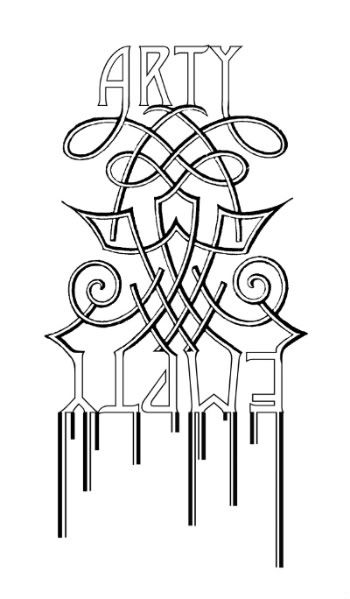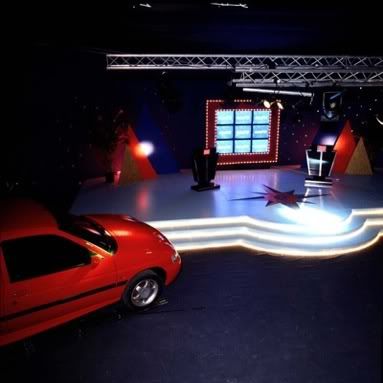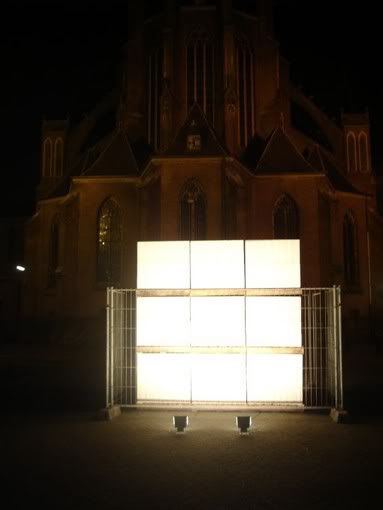Un artiste est un être qui par nature même cherche à se distinguer et à mettre en avant une unicité tant dans sa personnalité que dans son travail. Quoi de plus frustrant alors que d’être stupidement comparé à un simple homonyme, sans lien de parenté ou de correspondance directe dans l’approche ou la réalisation de son œuvre ? Qui plus est lorsque l’on est hollandais et que l’on vous rapproche d’un belge (les relations amicales entre les deux pays étant nettement distendues depuis près de deux siècles maintenant….minimum).
Seulement voilà, il n’est peut-être pas si ridicule d’établir, en dehors de leur patronyme, un parallèle entre Guillaume Bijl, artiste belge né en 1946 et Marc Bijl, artiste hollandais né en 1970. Sans lien de parenté, ils partagent pourtant des ancêtres communs : les primitifs flamands. Sans rentrer dans l’analyse des œuvres de Roger Van der Weyden, Robert Campin ou Jans Van Eyck (cf. Aile Richelieu, 2ème étage, Musée du Louvre), on peut dégager de manière raccourcie et éhontée les grands axes de leur caractère révolutionnaire : introduction du sacré dans le quotidien, attention jusqu’à l’obsession pour le détail et le rendu, luminosité et transparence surnaturelle par la dimension technique et idéologique. Autant de qualificatifs qui caractérisent les travaux tant de Marc que de Guillaume, eux aussi révolutionnaires dans l’âme (flamande). A croire que c’est dans les gênes tout ça....
La (fausse) famille Bijl aime à révéler notre quotidien, à analyser notre monde dans ses dimensions socio-économiques et géopolitiques. Alors que Guillaume se plaît à reconstruire notre environnement tragique dans sa banalité à l’intérieur d’institutions et autres galeries transformées en auto-école, supermarché, laverie ou encore dispensaire (ce qu’il nomme « Installations de présentation »), Marc, lui, réinterprète les symboles de nos sociétés (Lara Croft dans La Revoluzione siamo noi, le logo Nike dans Symbolic ou Bluetooth dans Symbolic IV), les détourne, les maquille pour mieux nous les faire assimiler dans leur perversité et leur pouvoir. Il y a dans leurs deux pratiques une sorte d’archéologie du présent qui s’instaure, n’hésitant pas à fouiller, exposer, sortir de terre une réalité enfouie seulement sous la fine couche de notre incapacité à déceler le vrai. Etudier le présent comme s’il était un passé pour mieux nous faire appréhender le futur immédiat relève d’un jeu étrange sur les notions de temps et de durée.
L’introduction du sentiment religieux chez nos frères ennemis est parallèlement abordée de manière frontale et explicite. Guillaume Bijl dans Het Nonneke Van Brugge et Archeological Site (une des « sorry installations ») soit respectivement un mannequin de religieuse assise devant un crucifix dans une imitation de la réalité, entre tromperie et ready-made trouvé, et un clocher d’église à peine déterré, oeuvre confinant au génie dans les relations à la religion et à la dimension à la fois chtonienne et mystique de celle-ci. Marc Bijl de la même manière se confronte à la religion dans Aftermath, une croix de métal enchâssée dans un bloc de béton, Oh God There is no God, drapeau hollandais brodé de la phrase, ou Fundamentality V, un bloc lumineux pris dans une structure de matériaux de constructions placé devant une église de Tilburg, interrogeant sur l’échange entre la portée métaphysique que l’on veut bien prêter à l’art minimal et le déclin de la religiosité et de l’attention respectueuse que l’on lui porte.
C’est enfin la portée contestataire qui relie le mieux les deux artistes. Le néerlandais en a même fait une vraie marque de fabrique. Tags (Terror ou Resist sur les colonnes d’entrée des institutions), symbole de paix en feu (The burning peace), statue de la liberté armée (Freedom)…. On pourrait multiplier les exemples de revendications et d’engagement qui pullulent dans l’oeuvre de Bijl (Marc). Pour le belge, c’est une rébellion contre le système sociétal et artistique qu’il a engagé dès le début de sa production. Détournements, comme on l’a vu, des espaces, expositions de collections muséales de bidets, de cuissardes de cuir, de pièces érotiques.... dans une critique formaliste qui n’épargne personne, des artistes eux-mêmes aux commissaires, des centres d’art à la marchandisation des oeuvres, de lui, aussi, à l’art lui-même.
Si Marc s’éloigne de la cause flamande dans une réalisation qui se veut plus brute et anarchique (coulures, écritures à main levée, scotchs et pochoirs dans une superbe série de rappels historicisants de Mondrian (un autre hollandais)), plus primitif du coup, Guillaume Bijl s’attache à créer une hyperréalité soignée, exécutant dans le détail ses installations falsifiées, même s’il sait aussi, par ses objets trouvés, se rapprocher d’une fulgurance punk. Tous deux créent une oeuvre élaborée et compacte qui demeure intimement baignée d’une luminosité transcendantale, remmémorant la « devotio moderna » flamande originelle.
Au fait, « Bijl » en français, c’est une hache. Marc et Guillaume sont donc fondamentalement, et charnellement, deux flamands bien équipés pour mener une guerre artistique... primitive.
Bijl, Guillaume & Marc: Primitive Flemish.
Our hostile brothers introduce religious feeling, frontally and explicitly. Guillaume Bijl on Het Nonneke Van Brugge and Archeological Site (one of the “sorry installations”), respectively a nun mannequin seated in front of a crucifix imitating reality, between trickery and found ready-made, and a church tower slightly dug up, a brilliant piece mentioning religion relationship and confronting its chtonian and mystic dimensions. Marc Bijl, in the same manner, confronts religion on Aftermath, a metal cross inserted in a concrete block, Oh God there is no God, a Dutch flag embroidered with this sentence, or Fundamentality V, a luminous panel set in building materials, put in front of Tilburg Church, questioning exchanges between metaphysical impact associated to minimal art and the decline of religiosity and the respectful attention we dedicate to it.
Finally, the anti-authority dimension is the strongest link between the two artists. It became a trademark for the Dutch one. Tags (Terror or Resist on the columns of the entry of institutions), peace symbol put on fire (The burning peace), armed Statue of Liberty (Freedom)… We could multiply examples of claims and commitments proliferating on (Marc) Bijl’s work. Concerning the Belgian one, the rebellion aims at societal and artistic system since the very beginning of his art production. Spaces hijacked (see above), exhibitions of museum collections of bidets, leather waders, erotic pieces…. on a formalist criticism that spares nobody, artists themselves and curators, art centers and art mercantilism, him and art itself too.
If Marc rejects the Flemish cause thanks to a raw and anarchic realization (drips, handmade writings, tapes and stencils on a great historicist reminding of Mondrian work (another Dutch artist)), more primitive then, Guillaume Bijl wishes to create a meticulous hyperreality, carrying out precisely falsified installations but he knows, through found objects, to get closer to punk violence too. They both create an elaborated and compact work, intimately shining of transcendental light, reminding Flemish genuine “devotio moderna”.



Aucun commentaire:
Enregistrer un commentaire